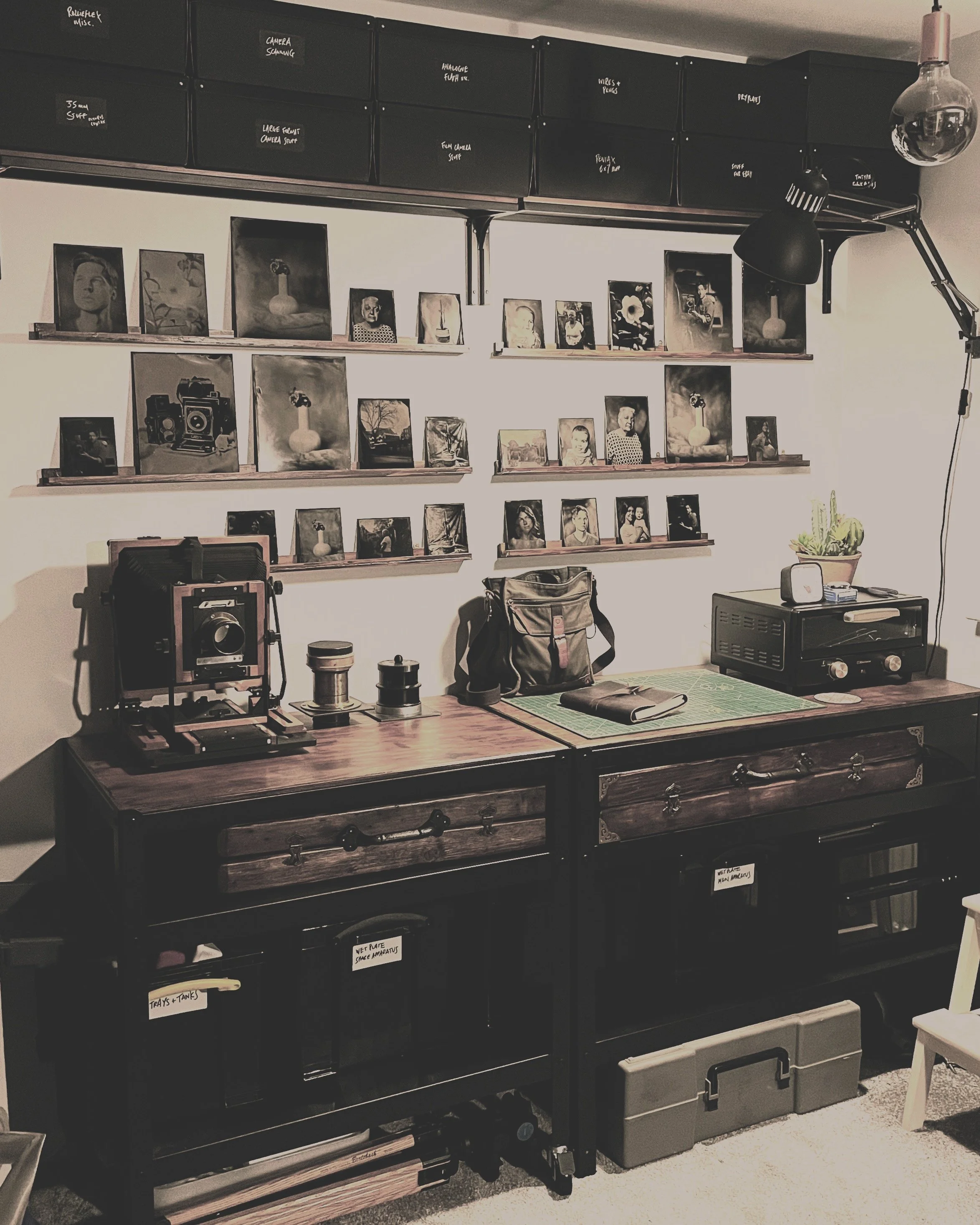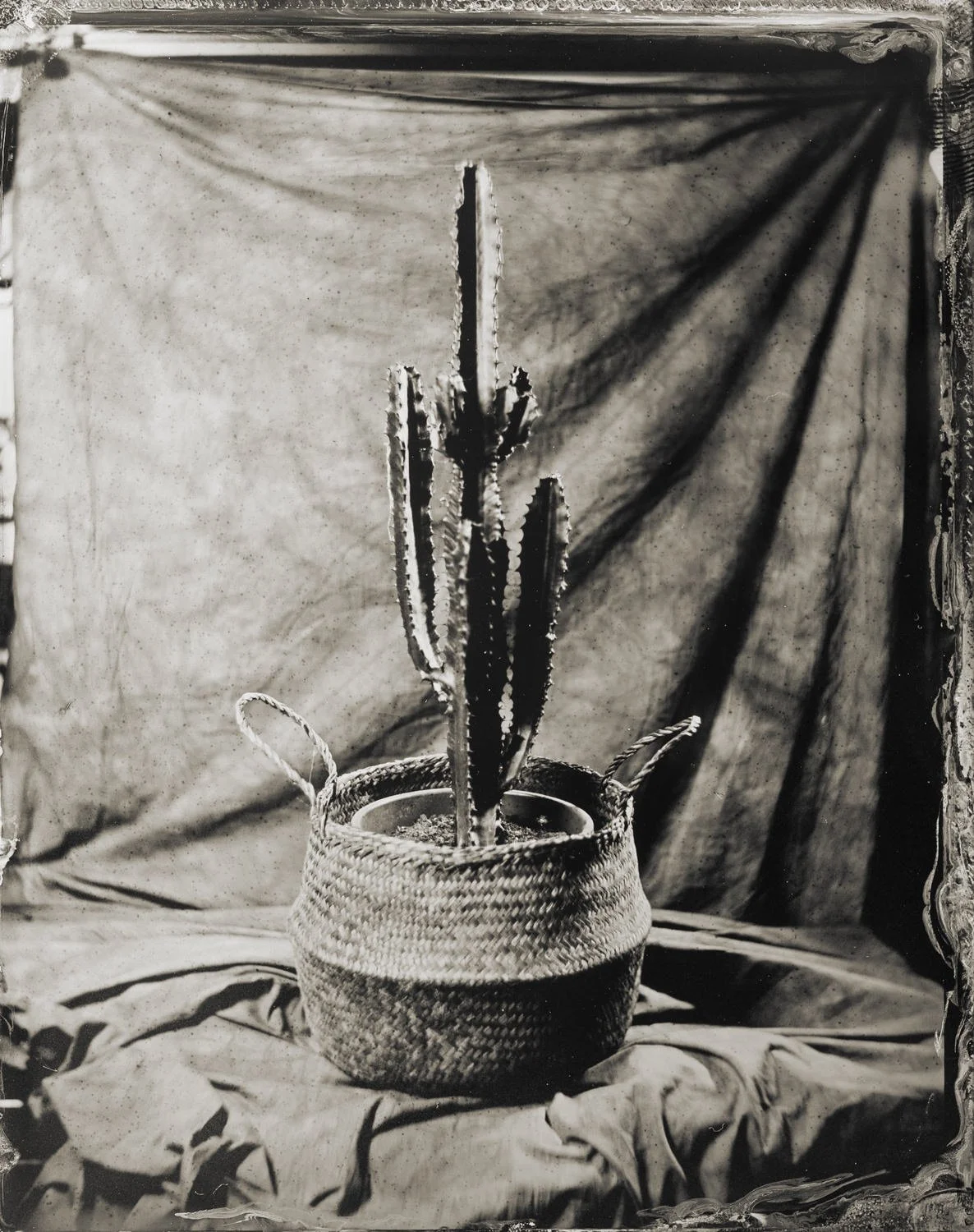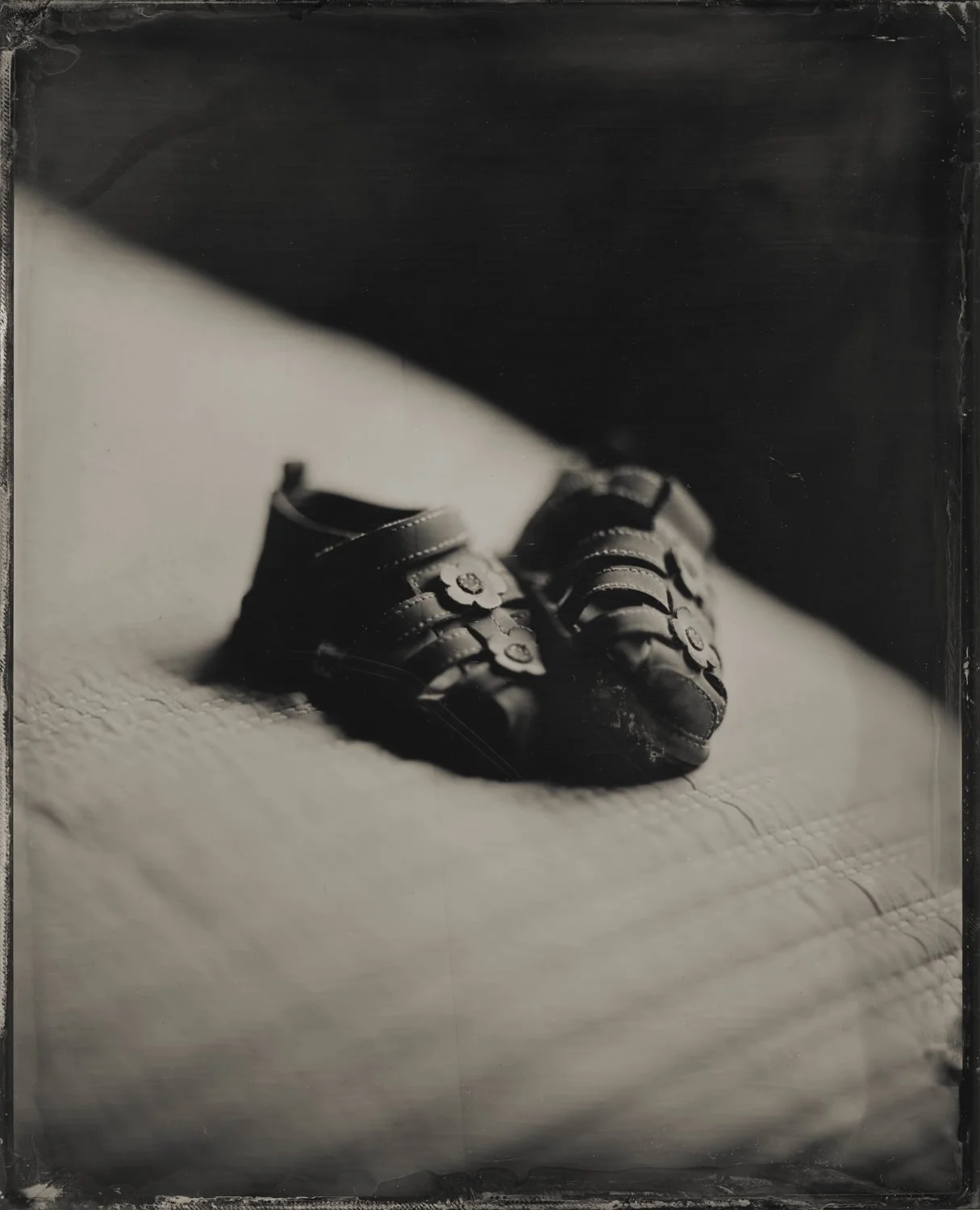
A tintype session is a bit different to your typical digital photoshoot. Tintypes are made using the wet plate collodion process from 1851. It’s a chemically intensive analogue process and requires skilled understanding of each step in the process to create a good plate.
The resulting images are one-of-a-kind handmade photographs on metal plates that last around 150-200 years once varnished. Please see below for more info on session prices, available plate sizes & lots more in the FAQs.

Tintype Sessions
*** I currently do not have a dedicated studio space for my wet plate work. Due to this, my wet plate work is fully mobile. This means there is a 1 hour set-up time for when I do both ‘Natural Light’ & ‘Studio’ tintypes. Click here if you would like to know the difference between natural light and studio tintypes. ***
If you would like to book a tintype session, a certain set of plates, or if you have any questions about me taking your tintype portrait, please get in touch for more information.
PLEASE NOTE: Due to set-up times and chemical maintenance I do not offer a session for just a single plate, Instead, I shoot at least 2-3 plates during a single session. This gives you the opportunity to pick your favourite(s) and then I also get a plate to keep for my archive.
Sunbeams or
The Studio?
The main differences of when I shoot Natural Light & Studio Tintypes:
Natural Light
• The original way of making tintypes
• Created primarily outdoors
• Exposure times are longer (~4-10 secs)
• Look quite soft & ethereal re: light & tones
• Does not require studio lights or backdrop
• Less set-up time is needed
• Depends on reasonable weather
• Available light & temperature affect plates
Studio
• The modern way of making tintypes
• Created primarily indoors
• Exposure times are faster (1 second)
• Have a ‘professional’ look, contrast & ‘pop!’
• Requires extra time to set up the studio
• Space needed is 3m x 3m minimum
• Can be created any time of the day
• Lighting can be consistent across plates
If you are unsure which type of session would suit you, just drop me a message via the contact form and I’ll get back to you with what I would recommend.

Tintype Plate Sizes
I offer tintypes in 3 plate sizes (inches):
-
Smallest plate size.
Ideal for individual portraits.
Groups: 2 people per plate max. -
Middle plate size.
Great for individual portraits & couples.
Groups: 3 people per plate max. -
Largest plate size.
Fantastic for portraits, couples & groups.
Groups: 5-6 people max.
Tintype Session FAQs
-
Tintypes come from the historical photographic process called ‘Wet Plate Collodion’, which was developed in 1851 by Frederick Scott Archer. This process was extraordinary in that it allowed ordinary people in the Victorian era to see themselves in a photograph for the very first time in human history. Images were created either directly onto a metal/tin plate (Tintype) or a glass plate (Ambrotype). I specialise in Tintypes which are direct positive images on the plate. Some people people describe this as ‘The Victorian Polaroid’.
The process, which is very hands-on and chemically intensive creates a unique ‘one of a kind’ photograph made of silver & light. Once a plate is varnished, the plates are expected to last around 150-200 years, creating an archival heirloom photograph that stands the test of time through generations of families. The Wet Plate Collodion process is an incredible way to create important and memorable photographs.
-
Set up takes roughly 45 minutes. Pack down takes 45 minutes - 1 hour.
Water - I need to know if I have access to water or if I need to bring my own. This is very important - mainly for washing the plates.
Shooting Space - In an ideal world I need an area no smaller than 3m x 3m. Studio Tintypes require an indoor space to build a lighting setup that has access to power/mains. If we are doing Natural Light Tintypes, I will ideally need to setup my dark box in the shade.
How long per plate? You should expect each plate I make to take about 20-30 minutes.
Sitters for Natural Light Tintypes will have to be still for up to 1-8 seconds depending on the quality of light outside. The available light dictates the timed exposure.
Sitters for Studio Tintypes will have to be still for 1 second. The available light dictates the timed exposure.
For your own safety, it is advised to not touch any chemicals/bottles during the session.
Tintypes are one-of-a-kind handmade photographs and can carry many imperfections in comparison to a digital photograph. Please bear this in mind. I will only re-shoot a plate if there are obvious marks/imperfections on a persons face or an important part of the photograph.
-
A session will be a bit different to your typical digital photoshoot. Set up takes roughly 45 minutes. Pack down takes 45mins - 1 hour (times may vary esp. for studio tintype shoots). A single tintype can take about 20-30 minutes. Once you are in front of the camera, it will require you to stay still for a few seconds to get a rough idea of focus and composition. I will then pour the plate and insert it into the silver tank for around 3 minutes. Once ready I will go into my portable Darkbox to prepare the plate - ready to be inserted into the camera. This is the moment where you will have to be completely still whilst I fine-tune focus and then make the exposure, which can range anywhere from 0.5 - 10 seconds. The available light dictates the exposure time for natural light tintypes, in comparison to a studio set-up which has much quicker exposure times. Once the exposure has been made I take the plate back into the dark box for development which can take about 1-2 minutes. I then bring the plate out of the dark box ready to go into the fixer - this is the magic part where an image slowly appears on the plate. The plate then needs to be washed for 20 minutes and then left to dry, ready for varnishing.
-
We will need to chat first to see which session is best for you and your needs. The quality of light and available space is usually top of my list of what dictates the session. Natural Light Tintypes are exactly what you’d expect and are shot in natural light outdoors. Studio Tintypes are shot primarily indoors using high-powered flash.
Natural Light Tintypes are created primarily outdoors and require slightly less setup time than studio portrait sessions. The exposure times are longer (potentially 1 to 4 seconds, maybe more) and they depend on the UK weather. These types of plates can look softer/dreamy in terms of light and tones.
Studio Tintypes can take longer to set-up, mainly to build the set, but they have considerably less exposure times than natural light sittings. Powerful flash strobes are used (potentially 2400-6000 watts of light). Final results tend to look more ‘punchy’ with incredible clarity, less soft in comparison to natural light tintypes. Both ways of lighting have their own strengths and weaknesses.
-
Patterns + Textures
Patterns and textures always look great. Textures that work well for tintype: plaid, tweed, denim, polka dot, gingham, animal prints, etc etc. The more contrast in your garment, the better. As for jewellery/accessories, they capture the light really as do sparkly garments if that's your thing.
Colour Differences
Tintypes translate colour differently than normal photographs. For instance, anything red/orange will appear quite dark - and blue garments will look a lot brighter than you'd imagine. This means if you wear a black and red plaid shirt it will mostly look black, and wearing a blue shirt with a white jacket will look mostly white. Blue eyes and freckles really pop in contemporary tintypes. For a great visual reference on this topic, please see this image from Mark Osterman’s Collodion Manual.
Solid Black & White Clothing
I normally recommend AGAINST wearing all black, as black fabric often doesn’t show up very well and you may end up looking like a floating head. There are very special exceptions to this, but if you decide to wear mostly black, consider bringing a change of clothes as a Plan B. White garments can -sometimes- look a little blown out, whilst black can -sometimes- lose a lot of details. Just something to bare in mind.
Footwear Consideration
Most of the photos I shoot are usually headshot or torso length portraits. If we are doing a full body shot, coordinating clothing and shoe options is a good idea as you don't want your nice outfit to be paired with old trainers.
Being Comfortable With Who You Are
Freckles, sunspots, and scars are more a little more pronounced in this process, however I believe this is what gives people true character, and shows who you really are. If you very self conscious and you plan on wearing makeup for a close up headshot, I would recommend applying it a little heavier than normal since this process can be highly detailed. But this is just a very mild consideration.
-
Avoid Letters / Numbers
Clothing with any sort of lettering, this is because it will appear backwards in the final photograph. Tintypes use a historical photographic process and the final image actually comes out printed in reverse.
Glasses / Lenses
Sometimes (not all the time) glasses can cause a problem as most lenses in glasses are coated, and they actually come out looking closer to sunglasses on tintypes. If you really want to wear glasses and don’t want them to look like sunglasses, then what might be a good idea is bring a spare old pair of glasses and pop out the lenses, as to not interfere with how the process renders modern lenses that you’ll find in prescription eyewear.
-
It is important to know that you will not leave the session with a tintype on the same day. The plate(s) will need to be scanned and varnished after the session. The plates then get dispatched & delivered to you. Plates are scanned for a high resolution digital file, and then the varnishing is done to protect the image. Turnaround times vary. On rare occasions processing can take much longer due to travel plans or unavailability. If you have a strict deadline, please let me know and I will do my best to accommodate this.
-
Yes, it is definitely normal. This is an imperfect process and due to the nature of the chemistry and everything being hand prepared, minor imperfections are very, very common & normal with tintypes. Every image is unique, handmade, and approached with care. I only offer to re-shoot an image if there’s an annoyingly large mark or imperfection on the person’s face or an important part of the photograph.
-
As a rule of thumb I try to shoot a max of 2 people for a 4x5 plate, 3 people for a 5x7 plate, and 4 people (maybe more) for an 8x10 plate. The depth of field is very shallow and small so there needs to be parameters I stick to so that we can attain ‘as sharp as possible’ focus on all subjects.
-
Yes. I can comfortably photograph up to four people for an 8x10 plate. If you wish to have a tintype made of a larger group please let me know as there will be slightly more planning and thought process on my part. There will be times where I will need to setup an outdoor or a bespoke on-site photo session - this will require fair weather and, for on-site sessions, a travel and setup fee. Outdoor sessions use natural light, therefore weather will govern what the exposure times are, which may be multiple seconds.
-
This depends. This process is inconsistent with pets due to them moving around too much. This makes it hard to focus on them in a timely manner. Email me if you are interested though and we can figure something out if your pet is capable of sitting still for an extended amount of time.
-
The concern is the same as with pets: kids don’t easily sit still. The process of large format photography requires the subject to sit still between the time of final focusing and inserting the photo-sensitive plate and taking the photo (about 10-15 seconds). During this time, any movement will likely result in being out of focus & the image will appear blurred. Keep this in mind when you want a family portrait with the young ones.
-
Due to the nature of this process and the chemicals, equipment and time involved, I do not offer refunds. If you need to reschedule, it requires 24 hours notice. In any case always notify me and we can sort something out.
-
You can use your portrait for personal prints for family members, Christmas cards or for anything that isn’t commercially reproduced.
-
Usage fees apply when the work is used for commercial or editorial purposes, and prices will vary depending on the use. Please email me for more information.
-
Absolutely! Email me to add prints onto your order.
-
The tintype will be coated in a shellac varnish to keep the silver from oxidising and to protect the image from scratching. Please be aware to not to expose this varnish coating to solvents like alcohol. The best thing you can do with your tintype is hang it (or place it) somewhere nice and bright, so you can admire it for many years to come. If it’s dusty, a soft/light brush can be used to get rid of the dust.


















